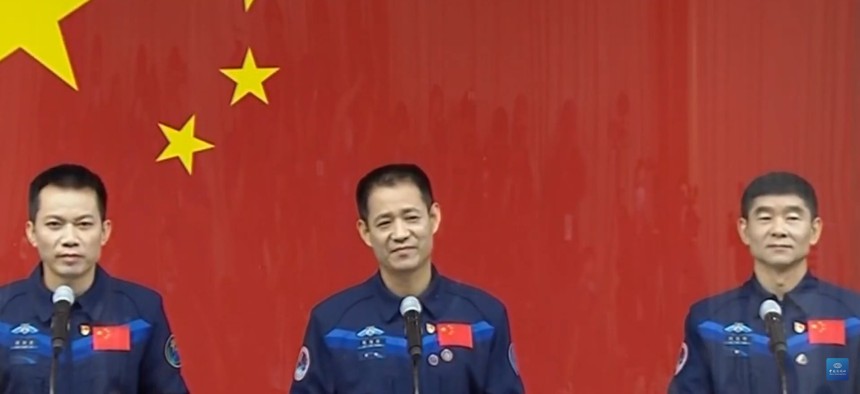TAYLOR A. LEE and PETER W. SINGER

On the 4th of July, China celebrated its taikonauts’ first-ever space walk outside the country’s first permanent space station, the Tiangong (“Heavenly Palace”). The extravehicular activity marked yet another major step for the country’s ambitious space program, and a vivid sign of what is to come. In the next five years, China intends to collect samples from a near-Earth asteroid, conduct two lunar polar exploration missions, and finish construction of its 60-ton space station.
This remarkable growth has led to a spate of recent international space cooperation programs with China, including European Space Agency and taikonauts training together and a reported 42 applications of interest for joint research programs. Some are urging the U.S. and China to collaborate in space as a means to dampen great power tension, though the Wolf Amendment has since 2011 effectively barred NASA from such cooperation.
The militarized tilt of the Chinese space program complicates these plans. Space planning and directing organizations, the ground infrastructure supporting its space programs, and the taikonauts themselves are all under the purview of the People’s Liberation Army. Understanding these connections is important for any plans to cooperate with China in space, whether governmental or commercial.
On the organizational side, China’s equivalent to NASA is the civilian China National Space Administration, which has a focus on the space program’s international exchanges. It falls under the State Administration for Science, Technology and Industry for National Defense, which handles defense-related science and technology, including China’s state-owned defense conglomerates. However, unlike NASA, the CNSA doesn’t oversee China’s astronauts. The organization actually in charge of China’s manned space program is the China Manned Space Engineering Office, which is under China’s Central Military Commission Equipment Development Department.
Likewise, the infrastructure of China’s space program is also heavily militarized. The launch sites, control centers, and many of the satellites are directly run by the PLA. Taikonauts lift off from the Jiuquan Satellite Launch Center (aka Base 20 of the PLA’s Strategic Support Force, its space and cyber arm); directed by the PLASSF’s Beijing Aerospace Flight Control Center, with Telemetry, Tracking and Control support from the Xi’an Satellite Control Center (aka the PLASSF’s Base 26); and land at one of two sites in Inner Mongolia operated by the two bases.
Finally, there is the human element. While most NASA astronauts are members of the U.S. military, others are civilian scientists and even teachers. In contrast, all taikonauts are active members of the PLASSF. They make up the Astronaut Corps under the PLASSF Space Systems Department’s China Astronaut Research and Training Center.
The first astronauts to fully undergo training at the Center, which began operations in the late 1990s, were all chosen from the PLA Air Force. (An earlier effort to establish a manned space program in the 1960s and ’70s faltered.) Since then, China has held two more rounds of taikonaut selection, with the most recent apparently taking some candidates outside the military, but as noted above serving under the PLASSF.
China does not always openly advertise the military affiliation of those in its space program. For example, the Chinese language website of the China Manned Space Engineering Office shows program commander Li Shangfu in military uniform, noting his main role as director of the Central Military Commission Equipment Development Department. But Shang Hong, the deputy program commander and PLASSF Space Systems Department Commander, appears in a suit. And on the English version, there are no uniforms (or leadership personnel) to be found.
To be sure, there are many links between America’s own space program and its military; for example, many launch and landing sites are military bases, such as Vandenberg Space Force Base and Edwards Air Force Base. But the degree of military control, lack of potential civilian intermediaries, the specific chain of command, and the broader “military-civil fusion” missions of some civilian institutions give China’s space program a significantly stronger military bent.
China’s push into space brings many potential cooperation opportunities in science, commerce, and exploration. However, the PLA’s direct involvement across much of the Chinese space program means caution is warranted. Any technology or sensitive information shared with these entities is flowing at the organizational, infrastructure, and human level to the PLA. This is significant because technologies used for spaceflight and spacecraft can be applied to weapons like intercontinental ballistic missiles, while space situational awareness capabilities can also be used for anti-satellite warfare.
While there are likely areas where the U.S. government or private companies could cooperate for common interest with the Chinese space program, such cooperation should involve a clear understanding of the militarized nature of much of China’s space program. To do otherwise, is to not just risk national security and intellectual property, but also to risk that such cooperation projects become future points of tension rather than their hoped-for bolstering of peace.
No comments:
Post a Comment